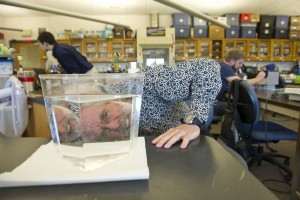[row][paragraph_left]
It’s build day for Colorado State University’s Little Shop of Physics, and there’s a whole lot of tinkering and experimenting going on.
Students and LSOP staff, many clad in their trademark LSOP tie-dyed shirts, are spread throughout an airy classroom that resembles a small warehouse. They are surrounded by dozens of cardboard banker’s boxes piled onto ceiling-high metal shelves and labeled with titles – Weird Ears, Sticky Liquids, Electrostatic Fleas, Bolt Eater – that illustrate the program’s legendary quirkiness.
Each box is filled with reusable materials and rescued objects that LSOP students and staff will turn into hands-on demonstrations of various physics and scientific concepts, such as motion and force.
[/paragraph_left][third_paragraph]
Did you know?
You can experience the Little Shop of Physics’ brand of tie-dyed science fun at its annual Open House on Saturday, Feb. 28. The Little Shop of Physics Open House runs from 10 a.m. to 6 p.m. at the Lory Student Center. The event is free and open to the public.
[/third_paragraph][/row]
Over the next several months, these experiments will be handled by thousands of children in classrooms and events throughout the region.
“We design and build all of the experiments that we take to classrooms and use in our large-scale events, such as Saturday’s open house here on the CSU campus and Weather and Science Day at the Colorado Rockies in April,” says Brian Jones, LSOP director and a longtime physics instructor in the College of Natural Sciences.
Science from scratch
The experiments are typically made from household and even second-hand materials, and they are as zany as they are intelligent. None come from pre-packaged science kits.
There’s a 50-gallon drum that implodes violently when the air gets sucked out of it by an off-the-shelf vacuum. Laser-beam “cloud slicers” show the complexity and beauty of weather patterns using a handed-down, still-sputtering home humidifier. A 3D optics experiment relies on a plastic spatula and an old record turntable. The list goes on. 
Jones has been organizing the weekly events – Tuesdays are build day for LSOP – since founding the renowned outreach program in the 1990s. A well-known campus character, he helps his student interns experience the pleasure of innovation and creation.
Today, Rachel Jones, a sophomore majoring in biological science, has been working on an electrical switch that controls a light bulb she’s put inside a fish tank. Her experiment is called the Cauldron of Convection, and its purpose is to demonstrate rising and falling cloud formations in a miniaturized system.
“These convection cells govern global weather patterns,” she says. “A fogger gives us vapor, and the light bulb creates heat. What I’m really looking for is a complete cell, with the vapor rising and then coming down again once it cools.”
As she talks, the wispy vapor starts to rumble at the bottom of the tank, rises lazily, and flows into a cohesive circular pattern.
Jones flashes a grin that conveys both giddiness and the satisfaction of a job well done.
But mostly giddiness.